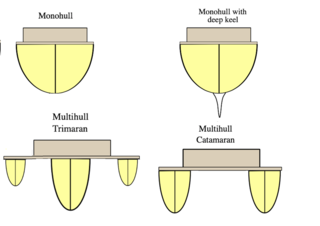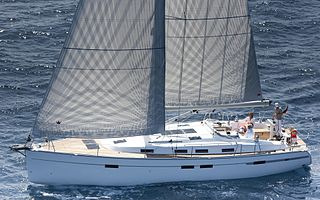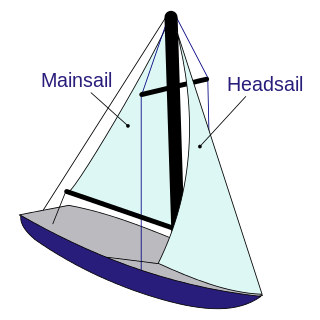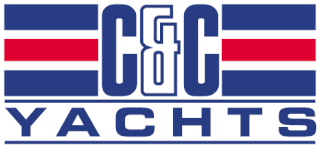
A multihull is a boat or ship with more than one hull, whereas a vessel with a single hull is a monohull. The most common multihulls are catamarans, and trimarans. There are other types, with four or more hulls, but such examples are very rare and tend to be specialised for particular functions.

A yacht is a sailing or power vessel used for pleasure, cruising, or racing. There is no standard definition, though the term generally applies to vessels with a cabin intended for overnight use. To be termed a yacht, as opposed to a boat, such a pleasure vessel is likely to be at least 33 feet (10 m) in length and may have been judged to have good aesthetic qualities.

A sailboat or sailing boat is a boat propelled partly or entirely by sails and is smaller than a sailing ship. Distinctions in what constitutes a sailing boat and ship vary by region and maritime culture.

A catamaran is a multi-hulled watercraft featuring two parallel hulls of equal size. It is a geometry-stabilized craft, deriving its stability from its wide beam, rather than from a ballasted keel as with a monohull boat. Catamarans typically have less hull volume, smaller displacement, and shallower draft (draught) than monohulls of comparable length. The two hulls combined also often have a smaller hydrodynamic resistance than comparable monohulls, requiring less propulsive power from either sails or motors. The catamaran's wider stance on the water can reduce both heeling and wave-induced motion, as compared with a monohull, and can give reduced wakes.
A monohull is a type of boat having only one hull, unlike multihulled boats which can have two or more individual hulls connected to one another.

The International 505 is a One-Design high-performance two-person monohull planing sailing dinghy, with spinnaker, utilising a trapeze for the crew.

The Westsail 32 was a production fiberglass sailboat built between the years of 1971 and 1980. Approximately 830 were built, about half of them in kit form. The "W32", as they are often referred to, was very heavily built and has taken many people on trouble-free voyages and several circumnavigations. Often thought of as a slow boat, the long waterline and incredible load carrying capabilities of this vessel make it an excellent cruising boat. The Westsail was directly derived from the earlier Kendall 32, of which only a few were made.

A sailing hydrofoil, hydrofoil sailboat, or hydrosail is a sailboat with wing-like foils mounted under the hull. As the craft increases its speed the hydrofoils lift the hull up and out of the water, greatly reducing wetted area, resulting in decreased drag and increased speed. A sailing hydrofoil can achieve speeds exceeding double and in some cases triple the wind speed.

C&C Yachts was a builder of high-performance fiberglass monohull sailboats with production facilities in Canada, Germany, and the United States. C&C designed and constructed a full range of production line cruiser-racer boats, as well as custom one-off and short production run racing and cruising boats. C&C boats ranged in size from as small as 21 ft (6.4 m) to as large as 67 ft (20.4 m). C&C also produced a line of bluewater cruising boats in the 35 ft (10.7 m) to 48 ft (14.6 m) range under its Landfall brand. In addition, C&C designed sailboats for production by a number of other manufacturers such as CS Yachts, Mirage Yachts, Northern Yachts, Ontario Yachts, Paceship Yachts, and Tanzer Industries.
This article attempts to give an overview of the design and manufacturing of sailboats and the evolution of this industry. Details should be found and contributed through linked articles.

Robert H. Perry is a U.S. yacht designer based in Seattle, Washington. Among his designs are some of the most successful cruising yachts in modern cruising such as the Tatoosh 42, Tayana 37 and Valiant 40. Through his career he has designed boats for many well recognized names in the yachting industry, such as Tayana, Cheoy Lee, Valiant, Baba, Ta Shing, Islander, Passport and Saga. Perry has taught yacht design at Evergreen State College.

A sailing yacht, is a leisure craft that uses sails as its primary means of propulsion. A yacht may be a sail or power vessel used for pleasure, cruising, or racing. There is no standard definition, so the term applies here to sailing vessels that have a cabin with amenities that accommodate overnight use. To be termed a "yacht", as opposed to a "boat", such a vessel is likely to be at least 33 feet (10 m) in length and have been judged to have good aesthetic qualities. Sailboats that do not accommodate overnight use or are smaller than 30 feet (9.1 m) are not universally called yachts. Sailing yachts in excess of 130 feet (40 m) are generally considered to be superyachts.
Cascade Yachts was a pioneering U.S.-based builder of fiberglass monohull sloop-rigged sailboats ranging in sizes from 23 to 42 feet (13 m) in length. It was founded in 1954 in Portland, Oregon by a group of local sailors interested in experimenting with fiberglass sailboat construction.

The Newport to Ensenada Yacht Race is an annual 125-nautical-mile international yacht race. First run in 1948, sailors gather each spring in Newport Beach, California, to participate in one of the West Coast's premier regattas. The Newport to Ensenada yacht Race (N2E) is a race to the city of Ensenada, Baja California.

The C&C 37/40 is a Canadian 12.05 metres (39.5 ft) LOA fibreglass monohull sailing yacht, designed in 1988 by Robert W. Ball of Cuthbertson & Cassian as a replacement for the earlier C&C 37 dating from 1981. The C&C 37/40 is a recreational keelboat of moderate displacement, intended as a cruiser/racer or oceangoing racer. The yachts have a masthead sloop rig, with a fin keel and an internally-mounted spade-type rudder. Over 110 of the 37/40 type were built before the Canadian plant closed in 1994. The design is no longer produced.

The Bluejacket 23 is a 23-foot (7.0 m) Canadian trailerable, fibreglass monohull sailboat designed by Cuthbertson & Cassian as a day sailer and club racer and first built in 1967.
The Landfall 35 is a sailboat, that was designed by Robert W. Ball, the chief designer of C&C Design, and first built in 1979. The Landfall series was part of a trend within C&C Yachts to develop more cruising-oriented designs under company president George Cuthbertson's direction during the later 1970s and early 1980s.
The Marlow-Hunter 31 is an American sailboat that was designed by Glenn Henderson as a cruiser and first built in 2015.
The Endeavour Yacht Corporation was an American boat builder based in Largo, Florida. Founded in 1974 by John Brooks and Rob Valdes, the company specialized in the design and manufacture of fiberglass sailboats. The company went out of business in 1986.
The MacGregor 19, also called the PowerSailer 19, is an American trailerable sailboat that was designed by Roger MacGregor as a cruiser and first built in 1992.